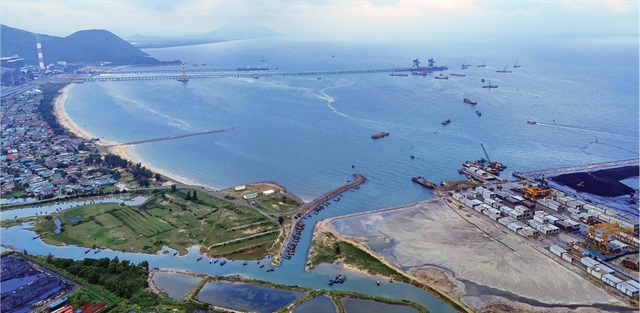 Opinion
Opinion

 |
| Vũng Áng - Sơn Dương port complex in Việt Nam. — VNA/VNS Photo |
Muthukumara Mani, Lead Environmental Economist at the World Bank, wrote to Việt Nam News, on a new report 'Boosting Việt Nam’s Sustainable Marine Economy – A Public Expenditure & Investment Review' (PEIR) to be launched on June 25.
Việt Nam’s 3,260km coastline and rich marine biodiversity are national treasures, its 'blue gold'. For centuries, the sea has shaped Việt Nam’s identity and supported millions through fisheries, tourism and coastal livelihoods. But overfishing, pollution, and climate change are pushing this critical resource to a tipping point. The question is no longer whether to develop the marine economy, but how to do so sustainably before the damage becomes irreversible.
A new World Bank report, 'Boosting Việt Nam’s Sustainable Marine Economy – A Public Expenditure & Investment Review' (PEIR), is the first global review of its kind to focus specifically on the marine economy. The analysis offers Việt Nam a data-driven roadmap to develop its ocean wealth responsibly. Prepared in partnership with the Ministry of Finance, the report is closely aligned with Resolution No. 36 (2018) of the Party Central Committee, which sets out Việt Nam’s strategic vision for sustainable marine economic development through 2045, and Resolution No. 26 (2020) of the Government, which translates this vision into concrete policies and action plans. The report highlights both the opportunities and risks across Việt Nam’s marine sectors and outlines a clear path toward long-term, sustainable growth.
 |
| Muthukumara Mani, Lead Environmental Economist at the World Bank. |
A vision rooted in ecosystems and culture
At the recent 3rd United Nations Ocean Conference in Nice, France, Prime Minister Phạm Minh Chính emphasised the need to deepen understanding of marine ecosystems and draw on indigenous wisdom. He called for harmony between economic development, biodiversity protection, and the preservation of cultural traditions. This aligns squarely with the approach outlined in the report: sustainable growth must integrate ecological health and local knowledge, not just GDP targets. Recognising the wisdom of coastal communities fosters stewardship and ensures development honours both nature and heritage.
A prosperous but fragile marine economy
Việt Nam’s marine economy spans 20 ecosystems – from coral reefs to mangroves – and has been growing rapidly. Before the pandemic, it contributed nearly 6 per cent of GDP and 8 per cent of employment. Tourism made up 45 per cent of the marine economy in 2019. Beyond direct activity, healthy ecosystems deliver essential services like storm protection and carbon storage, conservatively adding another 0.6 per cent to GDP. Mangroves alone account for 94 per cent of this hidden value, highlighting that nature protection is also an economic policy.
Yet this bounty is under threat. Fish stocks are collapsing under intense pressure. An estimated 730,000 tonnes of plastic waste enter Việt Nam’s waters annually, suffocating marine life. Disasters like the 2016 Formosa spill show the devastating cost of insufficient regulatory vigilance. Internationally, the EU’s 'yellow card' for illegal fishing illustrates how poor governance can damage Việt Nam’s global reputation and trade.
Climate change adds urgency. Over 11 million coastal residents face flooding. More than a third of shoreline communities are affected by erosion. Warming seas are killing coral reefs and threatening shellfish populations, jeopardising fisheries and tourism. The risks to livelihoods, ecosystems and resilience are growing.
Big goals, weak foundations
Việt Nam’s ambitions, enshrined in Resolutions 36 and 26, are bold: to grow the marine economy to 10 per cent of GDP by 2030, with a focus on sectors like tourism, renewables, and new blue industries. But achieving this will require more than vision. It calls for an overhaul of how the marine sectors are classified, financed, and governed.
The investment and expenditure review identifies several key gaps. Current classifications exclude emerging industries and overlook the value of ecosystem services. Investment in coastal provinces dropped from 27.2 per cent to 22.6 per cent between 2016 and 2022. Governance remains fragmented. Roughly 80 per cent of marine-related public spending still goes to transport, while sectors like offshore wind, sustainable aquaculture, and blue carbon remain underfunded.
A blueprint for sustainable ocean growth
To move forward, Việt Nam can benefit from integrating ecosystem services, like mangroves’ role in storm buffering and carbon capture, into its economic planning. Treating natural assets as critical infrastructure in national accounting and investment decisions could help align development with long-term resilience.
Shifting public funding toward high-impact areas, such as offshore wind research, sustainable aquaculture pilots, and blue carbon initiatives, can unlock innovation and create jobs. Sectoral support can also be realised by mobilising private capital through guarantees, blended finance, and simplified regulations.
Nature-based solutions, in particular, offer some of the most cost-effective and high-impact opportunities. Restoring mangroves and wetlands, expanding marine protected areas, and rehabilitating degraded coastal zones not only buffer climate impacts but also safeguard livelihoods and support fisheries, tourism and disaster risk reduction.
Empowering local governments with the tools and authority to plan and implement marine strategies tailored to their ecosystems can also enhance effectiveness. Decentralised approaches often enable more responsive, place-based solutions, particularly when combined with community engagement and local knowledge.
Sector-specific strategies will need to evolve. In the short term, improving near-shore aquaculture standards and value is key. In the longer term, offshore aquaculture can be developed through pilot projects. For tourism, shifting toward high-value, low-impact models, such as eco-resorts and community-led experiences governed by strong environmental safeguards, can contribute to sustainable growth.
Governance reform: A turning point
Strengthening governance will be critical to delivering on Việt Nam’s blue economy ambitions. The recent creation of the Ministry of Agriculture and Environment (MAE) from the two entities, formed through the merger of the Ministry of Agriculture and Rural Development (MARD) and the Ministry of Natural Resources and Environment (MONRE), presents a unique opportunity to streamline marine governance. This presents a timely opportunity to enhance coordination across marine sectors and bring greater coherence to policy and implementation. With appropriate authority, capacity, and inter-agency collaboration, MAE could serve as a central driver of integrated blue economy development.
Three priorities, where MAE’s leadership will be essential, include: (1) addressing illegal, unreported, and unregulated (IUU) fishing to lift the EU yellow card; (2) implementing marine spatial planning to resolve competing uses of coastal and ocean space; and (3) enforcing environmental regulations with real penalties to deter pollution and degradation.
The report’s broader reform agenda, cutting waste, aligning budgets with outcomes, and using performance metrics, is vital to ensuring that well-intended policies translate into real results.
The tide will not wait
Việt Nam is at a turning point. It can unlock a new era of sustainable marine prosperity – or watch its blue assets slip away. The choice is stark: continue fragmented, short-term exploitation, or embrace a “blue revolution” that values ecosystems, invests wisely, empowers communities, and insists on sustainability.
As Prime Minister Chính has highlighted, understanding marine ecosystems and honouring local traditions are key to balancing growth with conservation. The sea helped shape Việt Nam’s past. With bold leadership, it can power its future, not just in wealth, but in resilience. The roadmap is clear. Now is the time to act before the tide turns.




